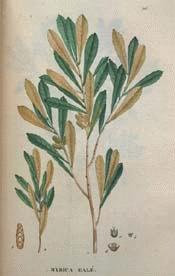

|
Sweetgale
(Myrica gale LINN.)
|
Gale, Sweet
Botanical: Myrica gale (LINN.)
Family: N.O. Myricaceae
---Synonyms---Bayberry. English Bog Myrtle. Dutch Myrtle. Herba Myrti Rabanitini. Gale palustris (Chevalier).
---Parts Used---Leaves, branches.
---Habitat---Higher latitudes of Northern Hemisphere; Great Britain, especially in the north; abundant on the Scottish moors and bogs.
---Description---The badge of the Campbells. A deciduous, bushy shrub, growing to 4 feet high. The wood and leaves fragrant when bruised. The leaves, not unlike a willow or myrtle, are oblanceolate, tapering entire at the base, toothed and broadest at the apex, the upper side dark glossy green, the underside paler and slightly downy, under which are a few shining glands. The male plant produces flowers in May and June in crowded, stalkless catkins. The fruit catkins about the same size, but thicker, are closely-set, resinous nutlets, the flowers being borne on the bare wood of one year's growth. The sexes are on different plants. The leaves are often dried to perfume linen, etc., their odour being very fragrant, but the taste bitter and astringent. The branches have been used as a substitute for hops in Yorkshire and put into a beer called there 'Gale Beer.' It is extremely good to allay thirst. The catkins, or cones, boiled in water, give a scum beeswax, which is utilized to make candles. The bark is used to tan calfskins; if gathered in autumn, it will dye wool a good yellow colour and is used for this purpose both in Sweden and Wales. The Swedes use it in strong decoction to kill insects, vermin and to cure the itch. The dried berries are put into broth and used as spice. In China, the leaves are infused like tea, and used as a stomachic and cordial.
---Constituents---Said to contain a poisonous volatile oil and to have properties similar to those of Myrica cerifera.
---Medicinal Action and Uses---The leaves have been used in France as an emmenagogue and abortifacient.
---Other Species---
M. Gale, var. tomentosa. The young wood and leaves on both sides are very downy and specially so on the underside.
See BAYBERRY.
[Top]
Common Name Index
A MODERN HERBAL Home Page
Bear in mind "A Modern Herbal" was written with the conventional wisdom of the early 1900's. This should be taken into account as some of the information may now be considered inaccurate, or not in accordance with modern medicine.
© Copyright Protected 1995-2004 botanical.com

|

